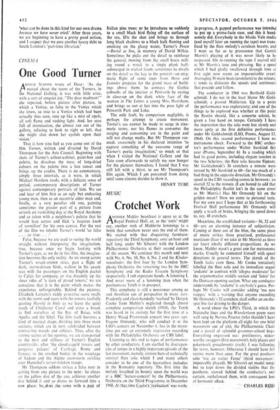One Good Turner
CINEMA
A RTHUR SYMONS wrote of Duse : 'As she moved about the room of the Turners, in the National Gallery, it was with little cries, with a sort of unquiet joy. "The dear madman!" she repeated, before picture after picture, in which a Venice, so false to the Venice which she knew, so true to a Venice which had been actually thus seen, rose up like a mist of opals, all soft flame and rushing light. And, her eyes full of intoxication, she almost ran out of the gallery, refusing to look to right or left, that she might shut down her eyelids upon their vision.'
That is how you feel as you come out of the film Turner, written and directed by David Thompson for the Arts Council. Beginning with shots of Turner's colour-cabinet, paint-box and palette, he dissolves the mess of long-dried colours on the palette into a late sunset and brings up the credits. There is no commentary, simply three intervals, as it were, in which Michael Hordern reads, with a delicate sense of period, contemporary descriptions of Turner against contemporary portraits of him. We see and hear of him first as an ugly but endearing young man, then as an eccentric older man and, finally, as a very peculiar old one, painting sometimes the greater part of a picture from scratch on varnishing day at the Royal Academy and so taken with a neighbour's palette that he would lean across and filch 'a luscious knob of vermilion' for his own canvas. For the rest of the film we inhabit Turner's world `so false . . . so true. . . .9 False, because we are used to seeing the world straight without interposing the imagination; true, because once we begin looking with Turner's eyes, as we do in this film, the imagina- tion becomes the only reality. As we sweep across Turner's wrack-strewn skies, past a flight of dark, storm-driven birds, wallow in his yeasty seas with the passengers on the English packet to C*lais for company, or rise dreamily up the sheer sides of 'a tiara of proud towers,' we are conscious that it is the paint which makes the experience unforgettable. Behind the pictures, Elisabeth Lutyens's richly evocative score swells with the storm and soars with the towers, tactfully quoting Harold in Italy as we leave the quiet reach of Chichester Canal and cross a brook to find ourselves at the Bay of Baiae, with Apollo and the Sibyl. The film itself borrows a kind of musical shape, dividing into three main sections, which are in turn subdivided between contrasting moods and subjects. Thus, after the stormy scenes of the opening, we are transported to the mist and stillness of Turner's English countryside; after 'the cloud-capp'd towers and gorgeous palaces' of Carthage, Rome and Greece, to the crushed bodies in the wreckage of Sodom and the Alpine snowstorm swirling over Hannibal's terror-stricken troops.
Mr Thompson seldom strikes a false note in getting from one picture to the next: he closes on the yellow disc of the sun, achieves another disc behind it and so draws us forward into a new place; heoitogts Alm same, with. apr pf Italian pine trees; or he introduces us suddenly to a small black bird flying off the surface of the sea, lifts the shot and brings us through long black shadows to a black hulk flaming and smoking on the glassy water, Turner's Peace —Burial at Sea, in memory of David Wilkie. Sometimes he picks out the detail to reinforce the general, moving from the small boats mill- ing round a wreck to a single plank half- submerged in wicked foam; sometimes he dwells on the detail as the key to the general—an enig- matic flight of stone steps from Hero and Leander prepares for the grand mass of build- ings above them; he conveys the Gothic cobwebs of the interior at Petworth by resting in close-up on the dank white face of the woman in The Letter. a young Miss Havisham, and brings us out at last into the pure light of PetwOrth Park and Lake.
The only fault, by comparison negligible, is perhaps the attempt to create movement. Turner's sea cannot be made to surge in cine- matic terms, nor his flames to consume; the surging and consuming are in the paint and will not change media. But Mr Thompson suc- ceeds awescmely in his declared intention `to capture something of the awesome range of Turner's poetic imagination,' so much so that when I visited the National Gallery and the Tate soon afterwards to satisfy my new hunger for the pictures themselves, I found that I was still left with a thirst, to see Mr Thompson's film again. Which I am prevented from doing until some cinema decides to show it.
HENRY TUBE


































 Previous page
Previous page